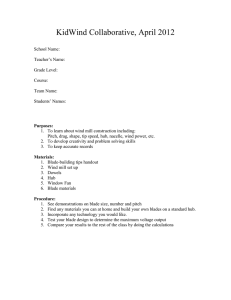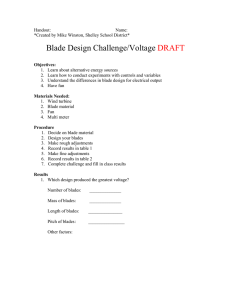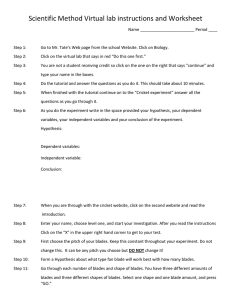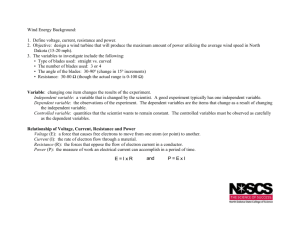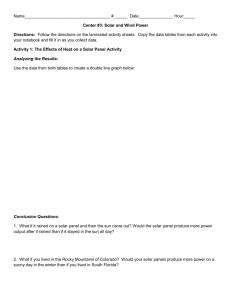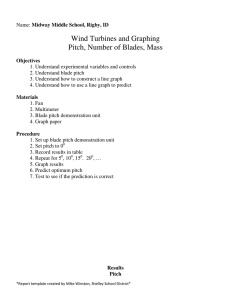KidWind Collaborative, April 2012
advertisement
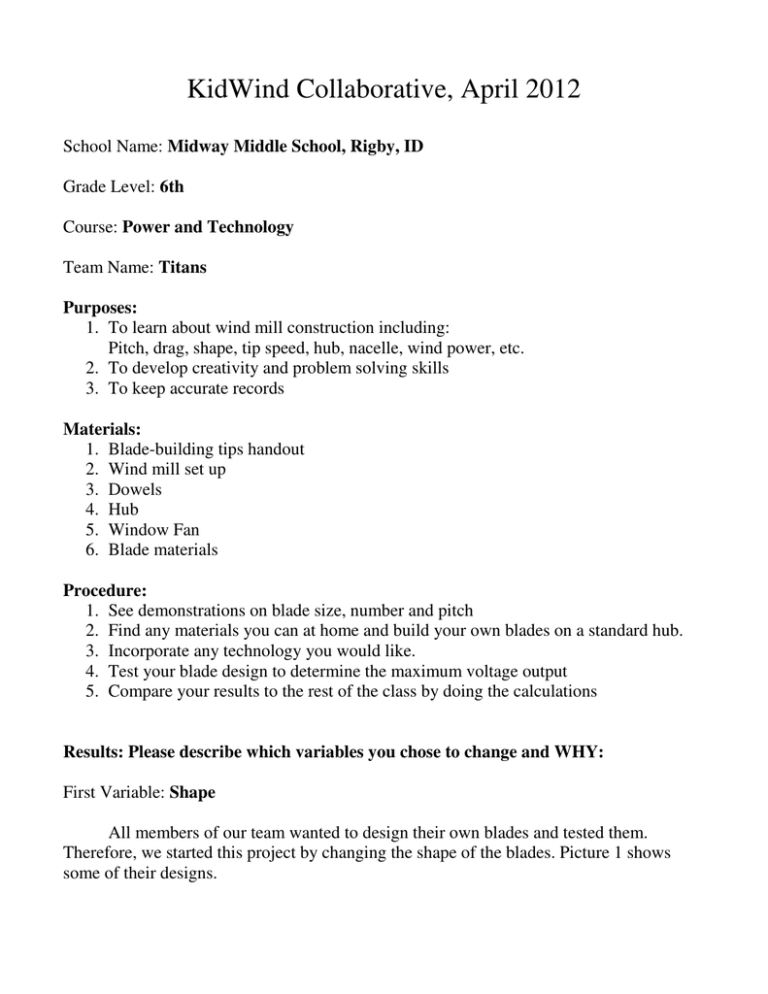
KidWind Collaborative, April 2012 School Name: Midway Middle School, Rigby, ID Grade Level: 6th Course: Power and Technology Team Name: Titans Purposes: 1. To learn about wind mill construction including: Pitch, drag, shape, tip speed, hub, nacelle, wind power, etc. 2. To develop creativity and problem solving skills 3. To keep accurate records Materials: 1. Blade-building tips handout 2. Wind mill set up 3. Dowels 4. Hub 5. Window Fan 6. Blade materials Procedure: 1. See demonstrations on blade size, number and pitch 2. Find any materials you can at home and build your own blades on a standard hub. 3. Incorporate any technology you would like. 4. Test your blade design to determine the maximum voltage output 5. Compare your results to the rest of the class by doing the calculations Results: Please describe which variables you chose to change and WHY: First Variable: Shape All members of our team wanted to design their own blades and tested them. Therefore, we started this project by changing the shape of the blades. Picture 1 shows some of their designs. Picture 1 We tested all the blades and we chose the design that gave us the highest voltage. Picture 2 shows the design that we chose. Picture 2 Second Variable: Pitch While testing their designs (shapes), our team members changed the pitch to see if they could get the highest voltage. So, we can say that we tested different degrees simultaneously with different shapes. From the data we collected, we realized that we got the highest voltage, for every design, at a very small angle (50). From here on, every test we performed, we did it at an angle of 5 degrees. Third Variable: Size At this point, our best design was the one shown in Picture 2. However, our team members made other blades with the same shape as in Picture 2 but bigger, and we notice an increase in the output. Here are some of the new designs: Picture 3 Form here, we just tried to improve the performance of our blades. In this way we got the final design for our blades (see Picture 4). Fourth Variable: Number of Blades Once we considered that our blades had the best shape, size, and were set at the best angle, we tested the number of blades. The output decreased dramatically while increasing the number of blades. The best results were when we had only two blades. Fifth Variable: Mass This was the last variable we tested. We thought that by increasing the mass by adding pennies to each of the two blades would decrease the voltage of the turbine but to our surprise we got high performance even though the mass was big. For example, three blades have a mass of approximately 25 gram and we got 2.52 v, but with almost the same mass, that is 27 grams (4 pennies total for the two blades), the voltage was 3.46 v. Also, for 6 blades which is about 47 grams the voltage was 2.07 v, but for a similar amount of mass, adding pennies, we got 3.1 volts. When we tested the two blades with one penny on each blade at 5 degrees, we got the highest voltage: 3.50 volts. Final Design 1. Number of blades: 2 2. Mass of blades and hub: 52 g 3. Radius of blades: 21.5 cm 4. Pitch of blades: 5 degrees 5. Sketch of blades Picture 4 6. Maximum output: 3.50 volts 7. Class average output: 3.43 volts 8. % variation: [(Max – min)/min] x 100 = [(3.50 – 3.35)/ 3.35] x 100 = 4.48% Conclusion Describe the design that produced maximum output. We show the details of the final design in the following pictures. Picture 5 Picture 6 Picture 7 Picture 8 Picture 9 Picture 10 Picture 11 What would you do differently to get the most voltage output? We would change the width of the blades, keeping a similar shape. Also, we would play with the height of the blades and with their mass. We also would consider other types of materials, perhaps a lighter one so that we would not affect the weight compared with the one that we currently have in our blades.
